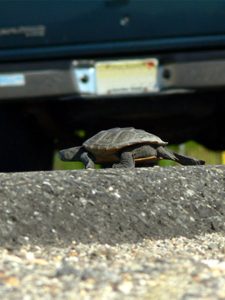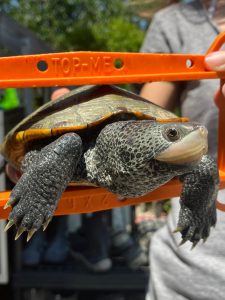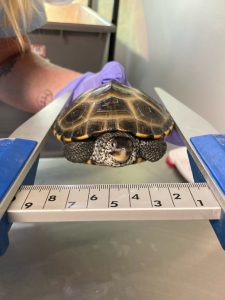
The diamondback terrapin (Malaclemys terrapin) is a mid-sized turtle that inhabits brackish waters of the United States from Cape Cod, Massachusetts to the Gulf of Mexico. More closely related to freshwater turtles than they are to sea turtles, diamondback terrapins are the only species of turtle in North America that can live their entire lives in the salt marsh. Within local marshes, terrapins prey on invertebrates such as fiddler crabs, snails, and small fish. Terrapins are keystone predators of periwinkle snails that graze smooth cordgrass (Spartina alterniflora), the primary plant species that makes up our salt marsh. When terrapins and other predators are removed, snails overgraze the cordgrass, leaving a barren mudflat. For this reason, healthy terrapin populations play an important role in maintaining salt marsh ecosystems. However, due to myriad threats including road mortality, bycatch in commercial crab traps, habitat degradation and loss, sea level rise, and predation by human-subsidized predators such as foxes and raccoons, terrapin populations are declining throughout their range. The diamondback terrapin conservation program at The Wetlands Institute was started in 1989 and has grown to encompass many different aspects of terrapin research and conservation.
Terrapins and Roads
 Since 1989, staff, interns, and volunteers have conducted regular patrols of local roads during the terrapin nesting season from May through August, helping nest-seeking female terrapins safely cross in the direction they are traveling. Live terrapins are moved out of harm’s way and injured terrapins are given aid or sent to rehabilitation professionals. When road-killed terrapins are encountered, researchers retrieve viable eggs through a process called an “eggectomy” and place them in incubators until they hatch. The hatchlings are raised in captivity for one year through our “head start” program in collaboration with local schools and universities, then are released into the wild.
Since 1989, staff, interns, and volunteers have conducted regular patrols of local roads during the terrapin nesting season from May through August, helping nest-seeking female terrapins safely cross in the direction they are traveling. Live terrapins are moved out of harm’s way and injured terrapins are given aid or sent to rehabilitation professionals. When road-killed terrapins are encountered, researchers retrieve viable eggs through a process called an “eggectomy” and place them in incubators until they hatch. The hatchlings are raised in captivity for one year through our “head start” program in collaboration with local schools and universities, then are released into the wild.
Keeping terrapins off the roads is another priority of our program. To this end, staff and volunteers of The Wetlands Institute have installed barrier fencing along local causeways. Since its inception in 2004, our barrier fencing project has tested many strategies and has expanded to include broad sections of coastal roads in Cape May County with particular focus on “hot spots” of terrapin road crossings identified from our road patrol data. We continue to trial new types of fencing and develop best practices to reduce costs and maintenance while improving barrier effectiveness.
Terrapins and Traps
 Our program has sought to increase awareness and understanding of the impact that bycatch has on terrapin populations. In states with a blue crab fishery, incidental drowning in crab traps is a major threat to terrapins. Naturally curious and attracted to bait, terrapins enter the traps, cannot escape, and can drown within a few hours. Even traps that have been lost or abandoned in the waterways and are no longer actively baited can be a significant source of terrapin mortality. Once terrapins and other animals become trapped and die in these “ghost traps”, their bodies become “bait” for terrapins, blue crabs and other marine organisms, creating a cycle that is only broken by removing the trap. Early research at The Wetlands Institute led to the development of bycatch reduction devices (BRDs) which reduce the size of crab trap funnels and prevent larger terrapins from entering traps. BRDs are now required in the state of New Jersey in bodies of water less than 150 feet wide; however, this excludes many important terrapin habitats. Researchers at The Wetlands Institute continue to document terrapin bycatch mortality and work with stakeholders and policymakers to devise practical measures for reducing this sizable threat.
Our program has sought to increase awareness and understanding of the impact that bycatch has on terrapin populations. In states with a blue crab fishery, incidental drowning in crab traps is a major threat to terrapins. Naturally curious and attracted to bait, terrapins enter the traps, cannot escape, and can drown within a few hours. Even traps that have been lost or abandoned in the waterways and are no longer actively baited can be a significant source of terrapin mortality. Once terrapins and other animals become trapped and die in these “ghost traps”, their bodies become “bait” for terrapins, blue crabs and other marine organisms, creating a cycle that is only broken by removing the trap. Early research at The Wetlands Institute led to the development of bycatch reduction devices (BRDs) which reduce the size of crab trap funnels and prevent larger terrapins from entering traps. BRDs are now required in the state of New Jersey in bodies of water less than 150 feet wide; however, this excludes many important terrapin habitats. Researchers at The Wetlands Institute continue to document terrapin bycatch mortality and work with stakeholders and policymakers to devise practical measures for reducing this sizable threat.
Terrapin Population Monitoring
 Another core component of our program is long-term monitoring of the local terrapin population through mark-recapture. Since 1997, researchers have caught and released terrapins at The Wetlands Institute or in nearby tidal creeks, recording body measurements, sex, and healed injuries. Each terrapin encountered receives a passive integrated transponder (PIT) tag, or microchip, which possesses a unique code that researchers can scan to identify the individual. This project allows us to interpret population trends and survival rates, and has taught us that several individuals in our population are over 30 years old! This long-term study is complemented by efforts to protect terrapin nests at our site by covering them with plastic mesh predator exclusion cages, so that vulnerable eggs and hatchlings are not predated.
Another core component of our program is long-term monitoring of the local terrapin population through mark-recapture. Since 1997, researchers have caught and released terrapins at The Wetlands Institute or in nearby tidal creeks, recording body measurements, sex, and healed injuries. Each terrapin encountered receives a passive integrated transponder (PIT) tag, or microchip, which possesses a unique code that researchers can scan to identify the individual. This project allows us to interpret population trends and survival rates, and has taught us that several individuals in our population are over 30 years old! This long-term study is complemented by efforts to protect terrapin nests at our site by covering them with plastic mesh predator exclusion cages, so that vulnerable eggs and hatchlings are not predated.
We also conduct studies on terrapin ecology, investigating terrapin movements, habitat use, nest site selection, and more to enhance our knowledge of these unique brackish water turtles and better inform conservation strategies. A component of our work is to assess terrapin response to marsh enhancement and restoration efforts. Studies examine terrapin use of nesting sites created or enhanced through beneficial use of dredged material, as well as terrapin use of salt marsh stabilized by dredged material placement.
Explore More
Join or Renew
Membership connects you with the wetlands and helps sustain our lifesaving work. Become a member or renew your support today.
